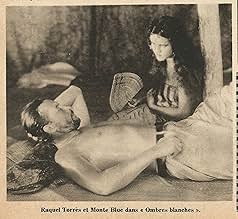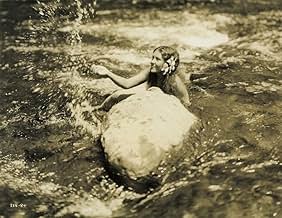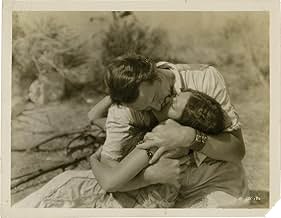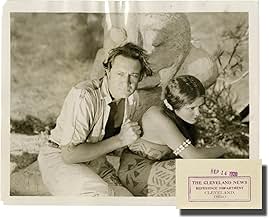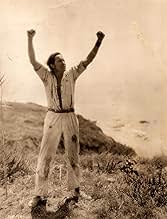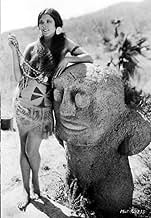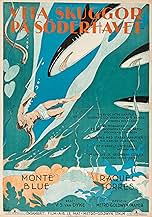IMDb RATING
6.8/10
1.1K
YOUR RATING
An alcoholic doctor on a Polynesian island, disgusted by white exploitation of the natives, finds himself marooned on a pristinely beautiful island.An alcoholic doctor on a Polynesian island, disgusted by white exploitation of the natives, finds himself marooned on a pristinely beautiful island.An alcoholic doctor on a Polynesian island, disgusted by white exploitation of the natives, finds himself marooned on a pristinely beautiful island.
- Won 1 Oscar
- 1 win total
Robert Anderson
- Sebastian - a Trader
- (uncredited)
Renee Bush
- Lucy
- (uncredited)
Dorothy Janis
- Native Girl
- (uncredited)
Napua
- Native Boy
- (uncredited)
Featured reviews
It still doesn't cease to amaze me how some Silent Movies, dramas or comedies, catch my attention so much, getting me so immersed in the plot, thus making me forget I'm watching a silent, an antique, a piece of history, enjoying the movie as I'd do with any "talking" movie.
In this case, the images are so real (it was filmed on location) and so hauntingly beautiful, that make many later Hollywood films from the 1940's or 1950's, which depict "South Seas Life" look unreal, fake, notwithstanding their possible entertainment value.
There's so much truth in this morality photo-play about a white man, identified as a "derelict" of the South Seas, previously a doctor, who finds "Paradise on Earth" (peace, love & happiness), on a certain island of the Polynesia. Monte Blue is great as this "white man".
Most of the featured players of the film, one realizes, are real natives from the islands, and this adds so much truth to the storyline. Beautiful actress Raquel Torres, does not seem (IMHO) out of place at all as Monte Blue's native love interest. And Robert Anderson is a very nasty villain.
There are some awesome underwater sequences, featuring octopuses, sharks, pearl-diving and others featuring palm-climbing, dancing, etc. Notice the different tinting (reddish, blue, sepia ...) of the sequences of the film; only at the beginning and on the end, plain black and white is used.
Great Sound score for this late "silent film", the first used for a MGM film and the first time Leo-the-Lion roared! The original South-Sea Islands Film. Excellent.
In this case, the images are so real (it was filmed on location) and so hauntingly beautiful, that make many later Hollywood films from the 1940's or 1950's, which depict "South Seas Life" look unreal, fake, notwithstanding their possible entertainment value.
There's so much truth in this morality photo-play about a white man, identified as a "derelict" of the South Seas, previously a doctor, who finds "Paradise on Earth" (peace, love & happiness), on a certain island of the Polynesia. Monte Blue is great as this "white man".
Most of the featured players of the film, one realizes, are real natives from the islands, and this adds so much truth to the storyline. Beautiful actress Raquel Torres, does not seem (IMHO) out of place at all as Monte Blue's native love interest. And Robert Anderson is a very nasty villain.
There are some awesome underwater sequences, featuring octopuses, sharks, pearl-diving and others featuring palm-climbing, dancing, etc. Notice the different tinting (reddish, blue, sepia ...) of the sequences of the film; only at the beginning and on the end, plain black and white is used.
Great Sound score for this late "silent film", the first used for a MGM film and the first time Leo-the-Lion roared! The original South-Sea Islands Film. Excellent.
In this little-known Van Dyke picture, the brilliant cinematography and acting cancel out the shallow plot and seemingly endless 'docu-footage' of the island. What it all adds up to is a very interesting, beautifully shot representation of an exotic place, with a bit of heavy-handed message to make it a story rather than a documentary. There is one exception to this, though, and it is a stunning one: the scene in which the 'white god' teaches the girl to whistle. It is surprisingly intimate, and acted wonderfully well. I recommend this one to fans of early cinematography.
Over time I've noticed how much I enjoy the pace of silent movies. Not being pushed and hurried is a very welcoming experience. Also the fact, that, in between the written dialog...you only rely on the physical expressions of the actors and your own imagination. And in my opinion that allows the viewer to enjoy the movie in his or her own unique way. This holds true for all silent movies. This movie would certainly seem to have been ahead of it's time. The statement made was loud and clear. The acting was good. The underwater scenes and the context they were presented in probably had the most impact on me.
Spreading from island to island, the WHITE SHADOWS IN THE SOUTH SEAS corrupt every culture they encounter.
This unfortunately obscure film, produced by MGM right at the cusp when the Silent Era was giving way to Sound, is a fascinating look at the vanishing way of life to be found in the South Pacific Islands. Its beautiful, vivid photography justly won the Oscar for Best Cinematography.
This 'Camera Record' was directed by W.S. Van Dyke, the Studio's on-location master. The film's prologue states "Produced and photographed on the natural locations and with the ancient native tribes of the Marquesas Islands in the South Seas." The footage depicting the pearl divers and the coconut tree climbers is particularly noteworthy.
Monte Blue gives a very fine performance as a derelict doctor who finds himself acclaimed as a white god on an island of gentle, friendly natives. His despair at the arrival of brutish Caucasian traders in this idyllic paradise is riveting. Mexican actress Raquel Torres, in her film debut, is poignant as the island maiden who captures Blue's heart.
This unfortunately obscure film, produced by MGM right at the cusp when the Silent Era was giving way to Sound, is a fascinating look at the vanishing way of life to be found in the South Pacific Islands. Its beautiful, vivid photography justly won the Oscar for Best Cinematography.
This 'Camera Record' was directed by W.S. Van Dyke, the Studio's on-location master. The film's prologue states "Produced and photographed on the natural locations and with the ancient native tribes of the Marquesas Islands in the South Seas." The footage depicting the pearl divers and the coconut tree climbers is particularly noteworthy.
Monte Blue gives a very fine performance as a derelict doctor who finds himself acclaimed as a white god on an island of gentle, friendly natives. His despair at the arrival of brutish Caucasian traders in this idyllic paradise is riveting. Mexican actress Raquel Torres, in her film debut, is poignant as the island maiden who captures Blue's heart.
How nice is it to see this treatment, this attitude, of the white man's imperialism towards native cultures in the 19th century, especially when other movies from this time period often had such blatant or casual racism. Here we clearly see the white man as the bad guy, greedy for pearls, exploiting the Polynesians, and spreading disease. It may be over the top and idealized at times, with some non-factual bits such as attacking octopi and grand proclamations against the white race as a whole, but its heart was certainly in the right place, and this notion of which party was evil was certainly correct.
Filmed on location in the Marquesas (or perhaps in reality Tahiti), it shows beautiful footage of the islands as well as the culture, such as people dancing, scaling coconut trees, shaving breadfruit, diving, fishing, and making fire. I'm not an expert but it feels authentic, and without a doubt, it's certainly respectful of the indigenous people. Director W.S. Van Dyke ("One Take Woody", who would go on to an Oscar nomination for "The Thin Man") pulls all the right strings here, from a fantastic typhoon scene, to intimate moments between leading man Monte Blue, and an island woman played by Raquel Torres. Most of the rest of the cast consists of real Islanders. Cinematographer Clyde De Vinna was worthy of the Oscar he won for the visual treats he gives us throughout the movie, and we also get a few bits of sound on MGM's first film with a pre-recorded soundtrack. What a hidden gem this film is for 1928.
Filmed on location in the Marquesas (or perhaps in reality Tahiti), it shows beautiful footage of the islands as well as the culture, such as people dancing, scaling coconut trees, shaving breadfruit, diving, fishing, and making fire. I'm not an expert but it feels authentic, and without a doubt, it's certainly respectful of the indigenous people. Director W.S. Van Dyke ("One Take Woody", who would go on to an Oscar nomination for "The Thin Man") pulls all the right strings here, from a fantastic typhoon scene, to intimate moments between leading man Monte Blue, and an island woman played by Raquel Torres. Most of the rest of the cast consists of real Islanders. Cinematographer Clyde De Vinna was worthy of the Oscar he won for the visual treats he gives us throughout the movie, and we also get a few bits of sound on MGM's first film with a pre-recorded soundtrack. What a hidden gem this film is for 1928.
Did you know
- TriviaAfter completing filming on the tropical island, they returned to the MGM lot at Culver City, where W.S. Van Dyke shot some additional material, including a typhoon at sea and a shipwreck. Then the studio decided to make Ombres blanches (1928) their first sound film, so they added a synchronized soundtrack consisted of a romantic score by William Axt and David Mendoza, with a few sound effects such as wind howling, a storm, trees ruffling and the words "Hello" and "wait."
This was MGM's first sound picture, and it premiered in Hollywood at Sid Grauman's Chinese Theater on Friday, 3 Aug 1928. It is known for being the first MGM film to be released with a pre-recorded soundtrack.
- GoofsThe drowned young man's left arm moves by itself.
- Quotes
Dr. Matthew Lloyd: For God's sake, go away, Sebastian... these people are like birds... like flowers... they are like man was before he lost the Garden of Eden...
- Alternate versionsThere is an Italian edition of this film on DVD, distributed by DNA srl, "L'UOMO DI ARAN (1934), NANUK L'ESCHIMESE (1922), OMBRE BIANCHE NEI MARI DEL SUD (1928)" (3 Films on a single DVD), re-edited with the contribution of film historian Riccardo Cusin. This version is also available for streaming on some platforms.
- ConnectionsFeatured in Settling the Score (2005)
- SoundtracksFlower of Love
(1928) (uncredited)
Music by William Axt and David Mendoza
Lyrics by Dave Dreyer and Herman Ruby
- How long is White Shadows in the South Seas?Powered by Alexa
Details
Box office
- Budget
- $365,000 (estimated)
- Runtime1 hour 28 minutes
- Sound mix
- Aspect ratio
- 1.20 : 1
Contribute to this page
Suggest an edit or add missing content


